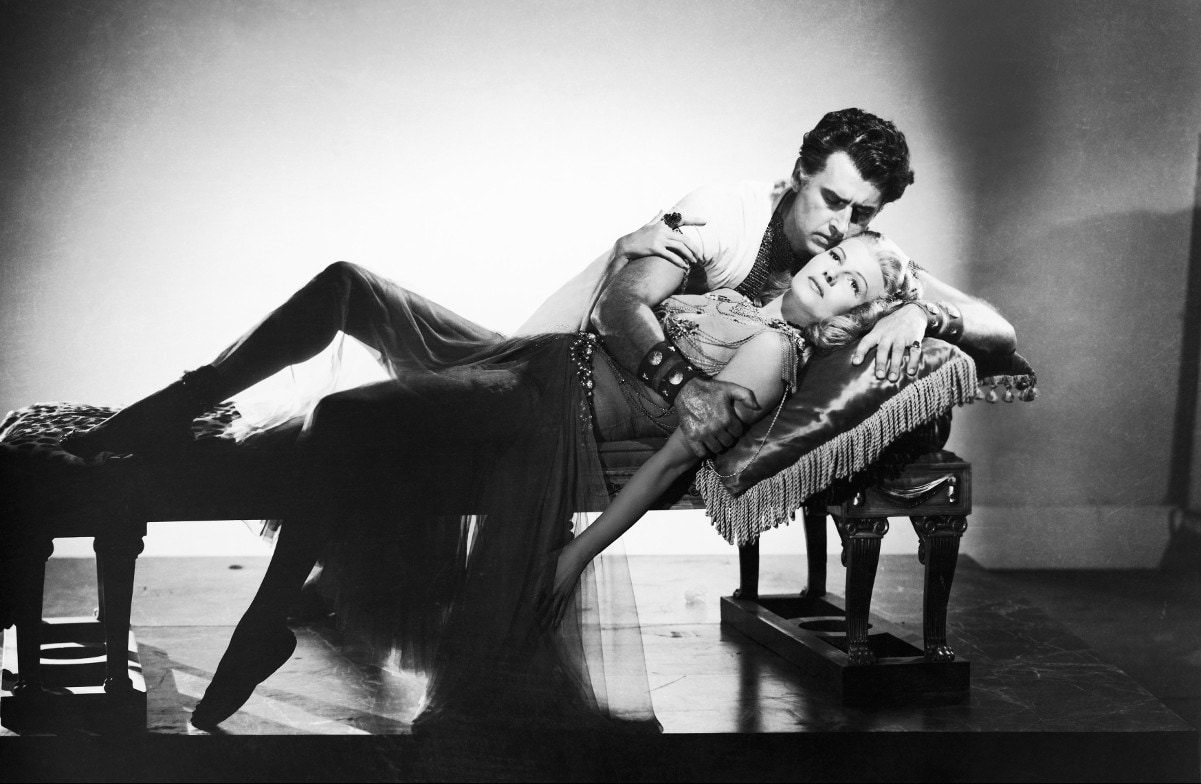Salome

Brief Synopsis
Cast & Crew
William Dieterle
Rita Hayworth
Stewart Granger
Charles Laughton
Judith Anderson
Sir Cedric Hardwicke
Film Details
Technical Specs

Synopsis
In the province of Galilee, under the rule of Rome's Tiberius Caesar, King Herod and Queen Herodias sit on the throne and are condemned by a prophet known as John the Baptist. Herodias bitterly resents John's denunciation of her marriage to the king, her former husband's brother, and the Baptist's claim that she is an adulteress. Herod, however, takes no action against John's seditious preaching, fearing that John may be the messiah foretold by prophecy. In Rome, Tiberius appoints Pontius Pilate as governor of Judea, where he is directed to maintain the peace. Caesar then rejects a petition from his nephew, Marcellus Fabius, who requests permission to wed the beautiful daughter of Herodias, Princess Salome, who has lived in Rome since childhood. Caesar reminds Marcellus that he must marry a Roman and, calling Salome a barbarian, banishes her back to Galilee. Salome departs Rome for Galilee on the same ship on which Pilate sails. During the voyage Commander Claudius flirts with Salome, but she remains aloof. Upon arriving in Judea, Salome and her escort, led by Claudius, come across a crowd of people by the river, who are being baptized by John. Claudius, who is a secret convert to the prophet's new religion, saves John when he is attacked for preaching against Rome. That night, Claudius slips away from Salome's camp and visits John, who warns him never to risk his life for him again. The next day at the palace, Herodias joyfully receives word of Salome's arrival, but worries about keeping her daughter safe from her stepfather Herod's well-known lechery. That evening at a formal supper welcoming the new governor, Herod is fawning over Salome, when a report arrives that John has entered the city. To Pilate's and Herodias' dismay, Herod refuses to order any action. Salome is puzzled by her mother's fear of John and remains skeptical when Claudius later reveals that he believes John is a prophet. A few nights later, Salome disguises herself in plain robes in order to attend a sermon delivered by John. When the Baptist condemns Herodias for ignoring the law, Salome defends her, but is startled when John recognizes her and warns her not to get caught up in the wickedness at court. Returning to the palace, Salome visits Herodias, who explains that if John is the messiah, as Herod believes, prophecy forbids that he be harmed. Salome suggests that her mother leave Herod, but Herodias reveals that she has remained only to ensure Salome's inheritance of the throne. Salome then pleads with Claudius to arrest John to appease her mother. Claiming that he has no authority to do so, Claudius refuses, leaving Salome hurt and disappointed. Desperate to put a stop to John's public accusations, Herodias arranges for an assassin to strike at John's next sermon, but Claudius, disguised as a local shepherd, intercedes and demands the assassin be taken to Herod. Although the man refuses to confess, Herod realizes Herodias is behind the attack and decides to bring John before the ministers for speaking treason. The following day, John's arrest stirs the people, and Salome, believing Claudius is responsible, is content. In the ministers' chamber, John declares that he is not the messiah and can only preach the truth, but the ministers, under Herod's coercion, find him guilty. Privately, Herod offers to save John's life if he will stop his denunciations, but John refuses and is imprisoned. Claudius beseeches Herod to free John as his imprisonment will bring about an uprising by the people, and when Herod refuses, the commander hurries to Jerusalem for an audience with Pilate. Claudius advises Pilate that a rebellion in Galilee may spread to the other provinces, but Pilate wants John executed. When Claudius urges Pilate to turn away from using force and try more peaceful methods, the governor realizes that Claudius has been converted. Because of their long friendship, he resists placing Claudius under arrest, but orders him back to Rome on the next available galley ship. Shortly thereafter, Claudius witnesses a sermon and healing of the sick by a carpenter who has been gaining reputation in the countryside. In Galilee, Herodias anxiously watches the growing public agitation for John's release and shocks Salome by asking her to gain Herod's favor by performing a dance at the feast that evening, then having him destroy John. Appalled, Salome seeks out Claudius, who takes her to John's cell and describes how the carpenter raised a man from the dead. Upon learning this, John declares that the carpenter is the prophesized messiah. Overcome, Salome confesses her sins and the Baptist blesses her. Claudius then tells Salome that he will risk his rank to free John, but she insists that she will perform for Herod and request John's freedom. That night, Salome dances for the king, who is mesmerized. Herodias then suggests he give her the Baptist's head and her advisor, Micha, quickly takes an executioner to John's cell, where Claudius' soldiers battle the palace guard. John is taken by Micha's men and beheaded, and his head is taken to Herod and the queen. Horrified, Salome denounces her mother and flees with Claudius to the countryside, where they find solace in the words of the carpenter.

Director

William Dieterle
Cast

Rita Hayworth

Stewart Granger

Charles Laughton

Judith Anderson

Sir Cedric Hardwicke

Basil Sydney
Maurice Schwartz

Arnold Moss
Alan Badel
Sujata And Asoka
Rex Reason

Robert Warwick
Carmen D'antonio
Michael Granger
Karl "killer" Davis
Joe Shilling
David Wold
Ray Beltram
Joe Sawaya
Anton Northpole
Carlo Tricoli
Franz Roehn

William Mccormick
Mickey Simpson
Eduardo Cansino
Barry Brooks
Lou Nova
Fred Letuli

John Wood
William Spaeth
Alel Pina
Jerry Pina
Henry Pina
Henry Escalante
Gillert Maques
Richard Rivas
Miguel Gutierez
Ramiro Rivas
Ruben T. Rivas
Hector Urtiaga
Duke Johnson
Earl Brown
Bud Cokes
George Khoury
Leonard George
Eva Hyde
Charles Wagenheim
Leslie Denison
Henry Dar Boggia
Michael Couzzi
Bobker Ben Ali
Don De Leo
John Parrish
Eddy Fields
Robert Garabedion
Sam Scar
Tris Coffin
Bruce Cameron
John Crawford
Guy Kingsford
Carleton Young
Michael Mark
David Leonard
Maurice Samuels
Ralph Moody
Saul Martell
Paul Hoffman
Stanley Waxman
Jack Low
Bert Rose
Tom Hernandez
Trevor Ward
Fred Berest

Rick Vallin
George Keymas
Roque Barry
Italia De Nublia
Davis Ahdar
Charles Soldani
Dimas Sotello
William Wilkerson
Mario Lamm
Tina Menard
Crew
Buddy Adler
Daniele Amfitheatrof
Earl Bellamy
Valerie Bettis
Clay Campbell
Francis Cugat
Lodge Cunningham
George Duning
Helen Hunt
William Kiernan
Harry Kleiner
Harry Kleiner
Charles Lang
Jesse L. Lasky Jr.
Viola Lawrence
Jean Louis
John Meehan
Arthur Morton
Roger Wagner Chorale
Emile Santiago
Millard Sheets
Morris Stoloff

Videos
Movie Clip



Trailer
Film Details
Technical Specs

Articles
Salome (1953)
The biblical epic, more or less invented by Cecil B. DeMille in the 1920s, had a Technicolor renaissance in the 1950s. DeMille himself kicked off the revival with Samson and Delilah (1949) which was followed by two of 1951's biggest hits, Quo Vadis? and David and Bathsheba. The following year, Columbia chief Harry Cohn was looking for a new project for his number one star Rita Hayworth. Jesse Lasky, Jr., who had written Samson and Delilah and was by then under contract at Columbia, suggested the story of Salome. But Cohn didn't want his star to play an evil woman, so Lasky changed the biblical story, making the teenage vixen a sympathetic heroine. In this version of Salome, the princess dances to save John the Baptist instead of having him beheaded. And she's attracted to the Baptist spiritually, not physically.
Unfortunately, Lasky didn't get to write the screenplay from his story, so any DeMillean style he might have given it was bogged down in Harry Kleiner's pedestrian script and William Dieterle's heavy-handed direction. In spite of that, Salome does have compensations that make it worth watching. Publicity for the film boasted that Salome was "the first biblical epic to have shot all its exteriors on the authentic historical locations." That was a bit of a stretch - Dieterle and his crew did shoot some desert exteriors in Israel, but others were shot in Palm Desert, California - but it's a sumptuous-looking film, thanks to Charles Lang's color cinematography. There are several outstanding performances, most notably Charles Laughton as Herod, and Judith Anderson as his wife Herodias. Both actors were at their best playing obsessive characters - Laughton's Nero in The Sign of the Cross (1932) and Anderson's Mrs. Danvers in Rebecca (1940) are unforgettable - and in Salome they play their evil couple without restraint, a dueling duo of intensity, fury, manic energy and prime-cut ham.
Hayworth's dancing skills, too rarely used in her recent films, were on full display in Salome, in intricate dances created by renowned choreographer Valerie Bettis, who had previously created Hayworth's dances in Affair in Trinidad (1952). Far from a teenager, Hayworth was still glamorous and desirable enough to play a temptress. But as a 35-year old mother of two, her body was hardly girlish. It was up to costume designer Jean Louis to give her a youthful figure in her provocative costumes. He invented a flesh-colored elastic body stocking that shaped Hayworth's body under the seven veils, but made her appear nude, save for strategically-placed jewels - a sort of full-body girdle, the precursor of today's "Spanx." Marlene Dietrich saw those costumes and asked Jean Louis to design similar gowns from the same material for her nightclub act, which left audiences marveling at the youthful figure of the glamorous grandmother.
Hayworth's importance to Columbia is evident in the fact that Salome was co-produced by Beckworth, Hayworth's production company. But if she was on top professionally, her personal life was in disarray. Her much-publicized marriage to international playboy Prince Aly Khan had ended in 1951, after less than two years. She filed for divorce, and the following year she resumed the movie career she had abandoned when they married. During the filming of Salome, Khan arrived in Hollywood to try to win her back. During his visit, the couple's three year-old daughter Yasmin found an open bottle of sleeping pills and swallowed them. The couple rushed the child to the hospital, and the crisis brought them closer together. Hayworth agreed to join her estranged husband in Europe after the film wrapped, but the reconciliation was short-lived. Soon after, Hayworth began seeing singer Dick Haymes, and married him in September, 1953. That marriage also lasted less than two years.
Stewart Granger, then MGM's top swashbuckler, was borrowed by Columbia to play Hayworth's love interest in Salome. Like Hayworth, he was preoccupied with personal matters during production. He and his wife, actress Jean Simmons, were involved in a court fight to get her out of her contract with Howard Hughes. Their efforts were ultimately successful.
Salome was also a success, at least with the public, which was intrigued by all the publicity about the supposedly lascivious dance of the seven veils. The critics were less enthralled. Time magazine called it "A turgid multimillion-dollar blend of sex, spectacle and religion...directed with a ponderous touch by William Dieterle." However, the Time critic was grudgingly admiring of Hayworth's efforts: "She writhes, wriggles, and undulates through this predecessor of the modern striptease with such abandon, as she removes as many veils (six) as the law and the Breen Office will allow, that moviegoers may come away with the feeling that never before has history been so colorful." Bosley Crowther of the New York Times found Salome "A lush conglomeration of historical pretenses and make-believe, pseudo-religious ostentation and just plain insinuated sex." No doubt reviews like those attracted more audiences than it repelled, and contributed to Salome's success at the box office.
Director: William Dieterle
Producer: Buddy Adler
Screenplay: Harry Kleiner, based on a story by Kleiner & Jesse Lasky, Jr.
Cinematography: Charles Lang
Editor: Viola Lawrence
Costume Design: Jean Louis, Emile Santiago - men's costumes
Art Direction: John Meehan
Music: George Duning, Daniele Amfitheatrof - music for dances
Cast: Rita Hayworth (Princess Salome), Stewart Granger (Commander Claudius), Charles Laughton (King Herod), Judith Anderson (Queen Herodias), Sir Cedric Hardwicke (Tiberius Caesar), Basil Sydney (Pontius Pilate), Maurice Schwartz (Ezra), Alan Badel (John the Baptist).
C-103m.
by Margarita Landazuri

Salome (1953)
Quotes
Why waste a slave?- Commander Claudius
Why not? The world's full of them.- Pontius Pilate
Trivia
Notes
Working titles of the film were Dance of the Seven Veils and Salome-the Dance of the Seven Veils. A February 13, 1952 Los Angeles Times news item announced that Robert Ardrey would be writing the script, but his contribution to the final film has not been determined. The same item stated that the film was to be based on the novel Good Tidings by William Sidney, but there is no indication that that author ever published a book by that name. Director William Dieterle did write a novel in 1950 titled The Good Tidings, but it is not known if Dieterle's book has any connection to the film. According to New Testament accounts in the books of Matthew and Mark, the real Princess Salome (1st century A.D.) was the granddaughter of Herod the Great (73-20 B.C.) and daughter of Herodias and Herod Philip. Unlike the story presented in the film, after Salome's dance for her stepfather Herod Antipas, she requested the head of John the Baptist at the behest of her mother.
Rita Hayworth's father, Eduardo Cansino, was cast in a small role as a Roman guard. A Hollywood Reporter news item adds Peter Brocco in the cast, but he was not identifiable in the print viewed. The picture marked the American feature film debut of English actor Alan Badel. Information in the file on the film in the MPAA/PCA Collection at the AMPAS Library indicates that studio head Harry Cohn worked closely with the PCA to minimize protests from the Catholic Legion of Decency about the portrayal of "a lascivious dance in a picture dealing with John the Baptist and Christ." The PCA also closely monitored Hayworth's wardrobe for the dance, to avoid the suggestion of a "striptease." The Legion gave the film a "B" rating upon its release. Columbia came under strong criticism by the Allied States Association of Motion Picture Exhibitors for limiting prerelease engagements of Salome to qualifying theaters in cities of 75,000 people or more and charging higher admission prices.
The story of Salome has been filmed many times. American versions include the 1918 Fox film Salome starring Theda Bara and directed by J. Gordon Edwards (see AFI Catalog of Feature Films, 1911-20); a 1922 Allied Productions film starring Nazimova and directed by Charles Bryant; and a 1923 George H. Wiley film starring Diane Allen and directed by Malcolm Strauss (see AFI Catalog of Feature Films, 1921-30).















